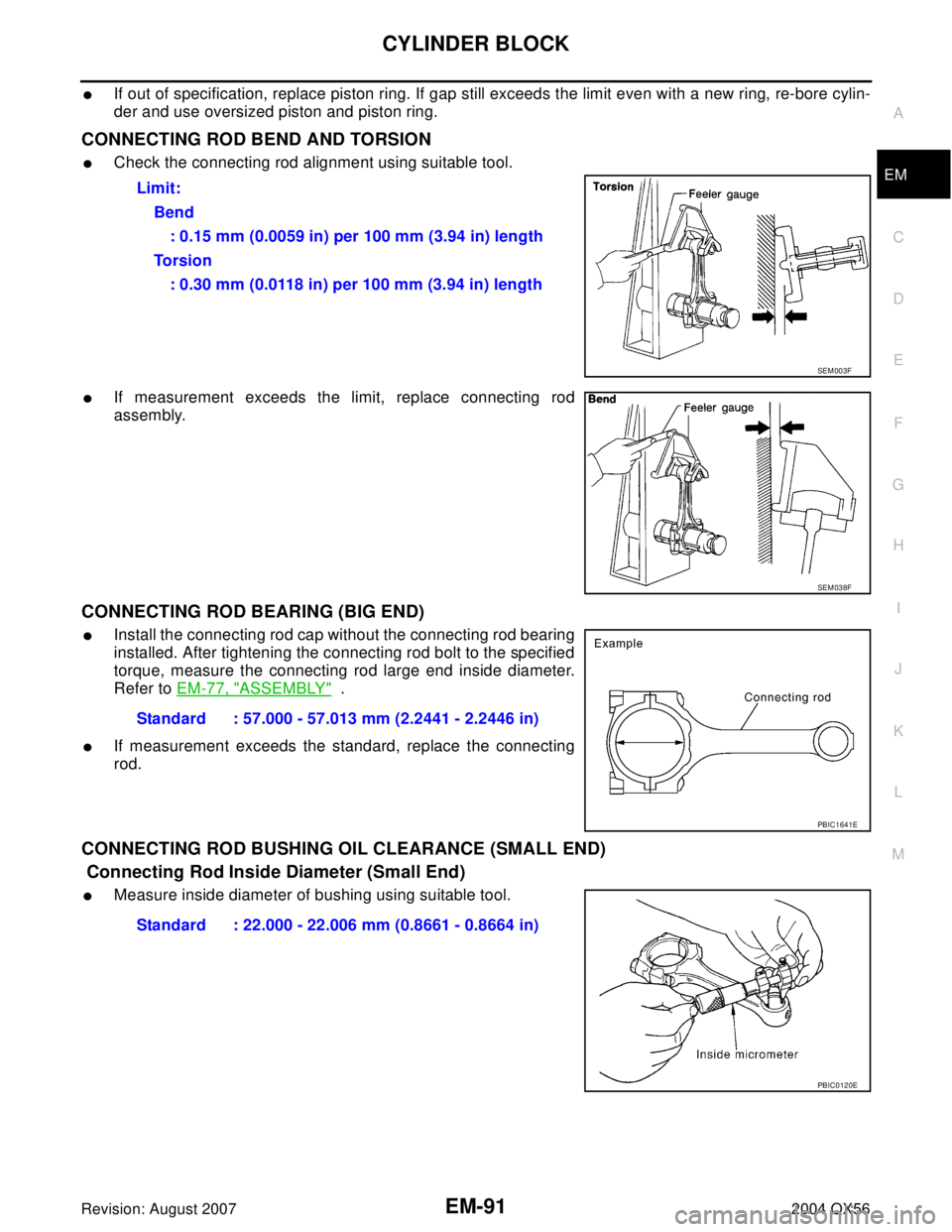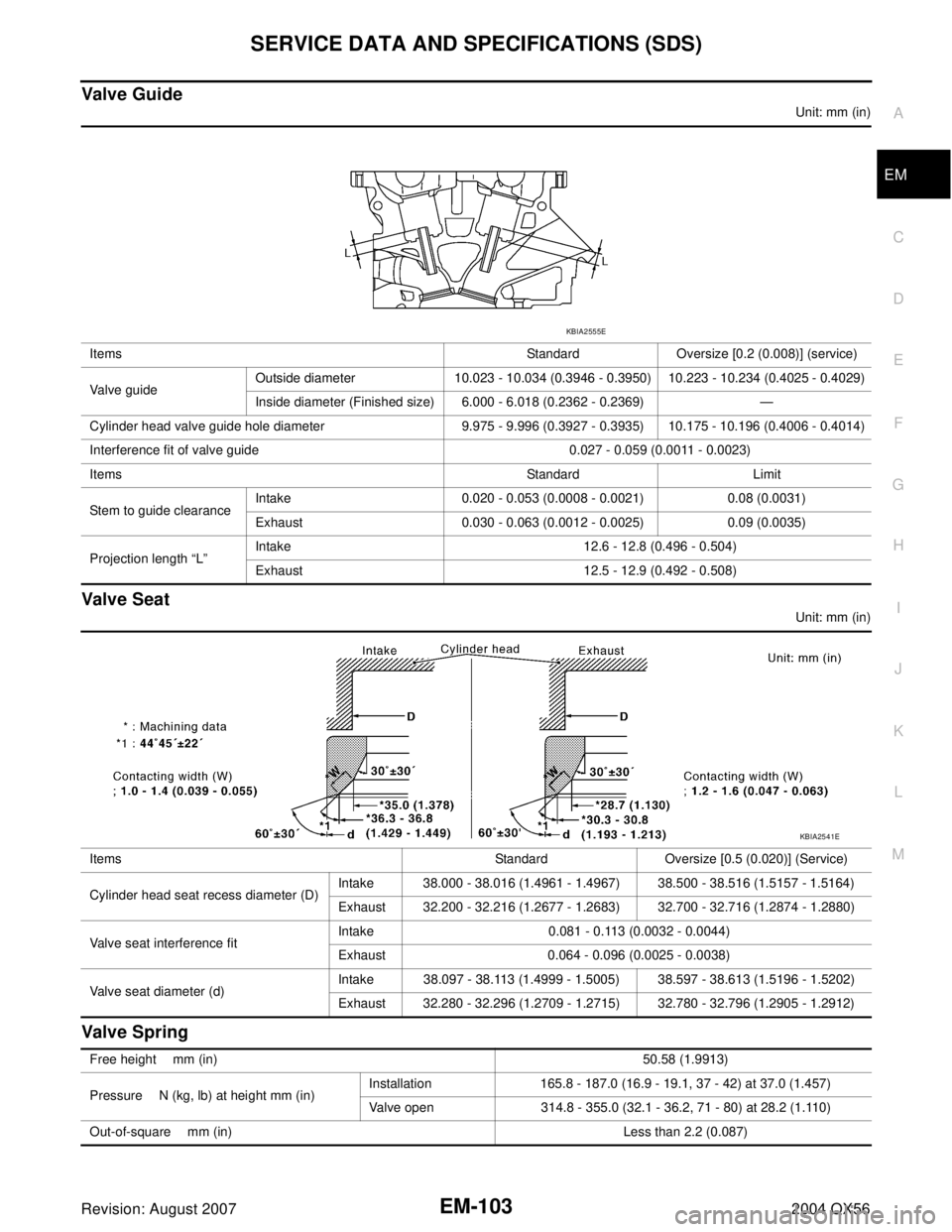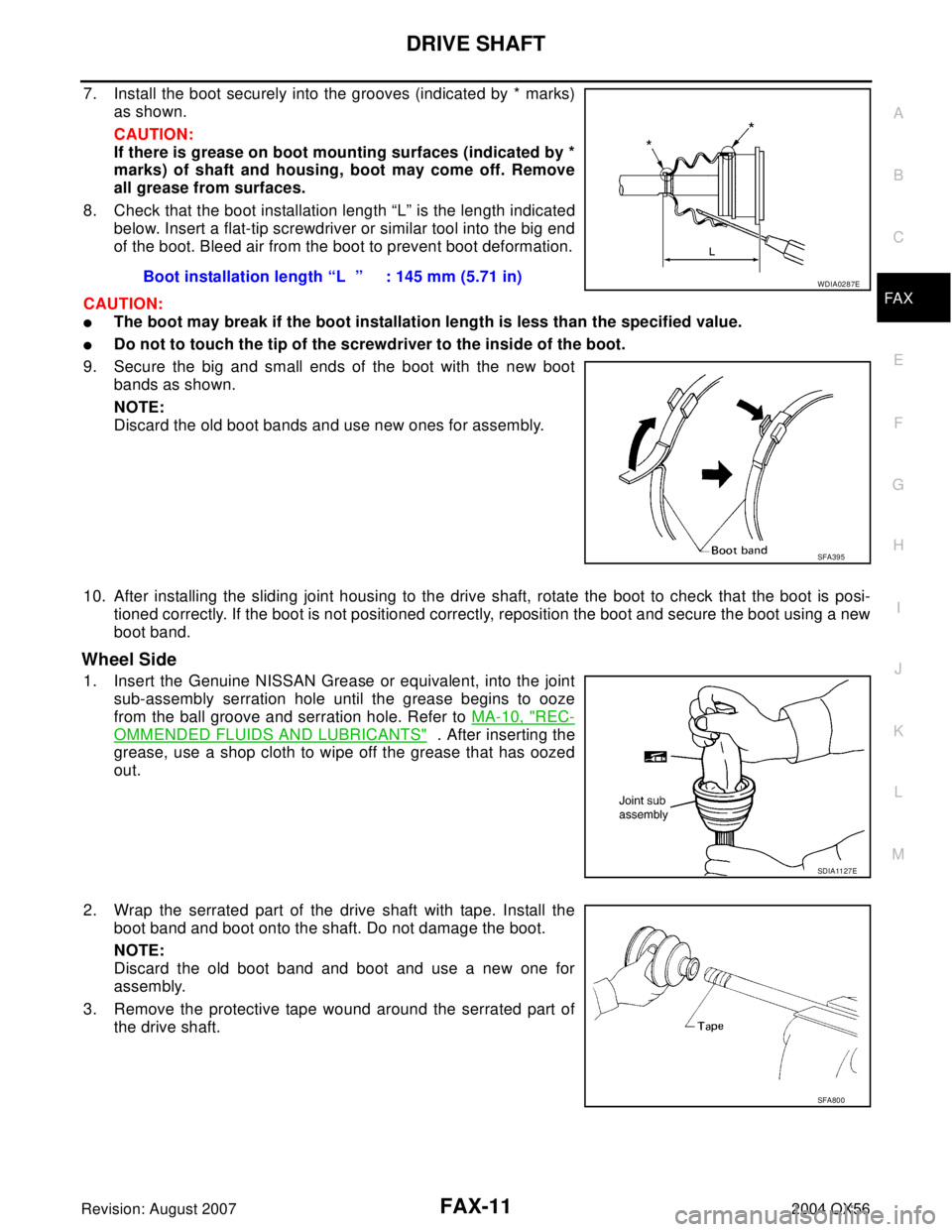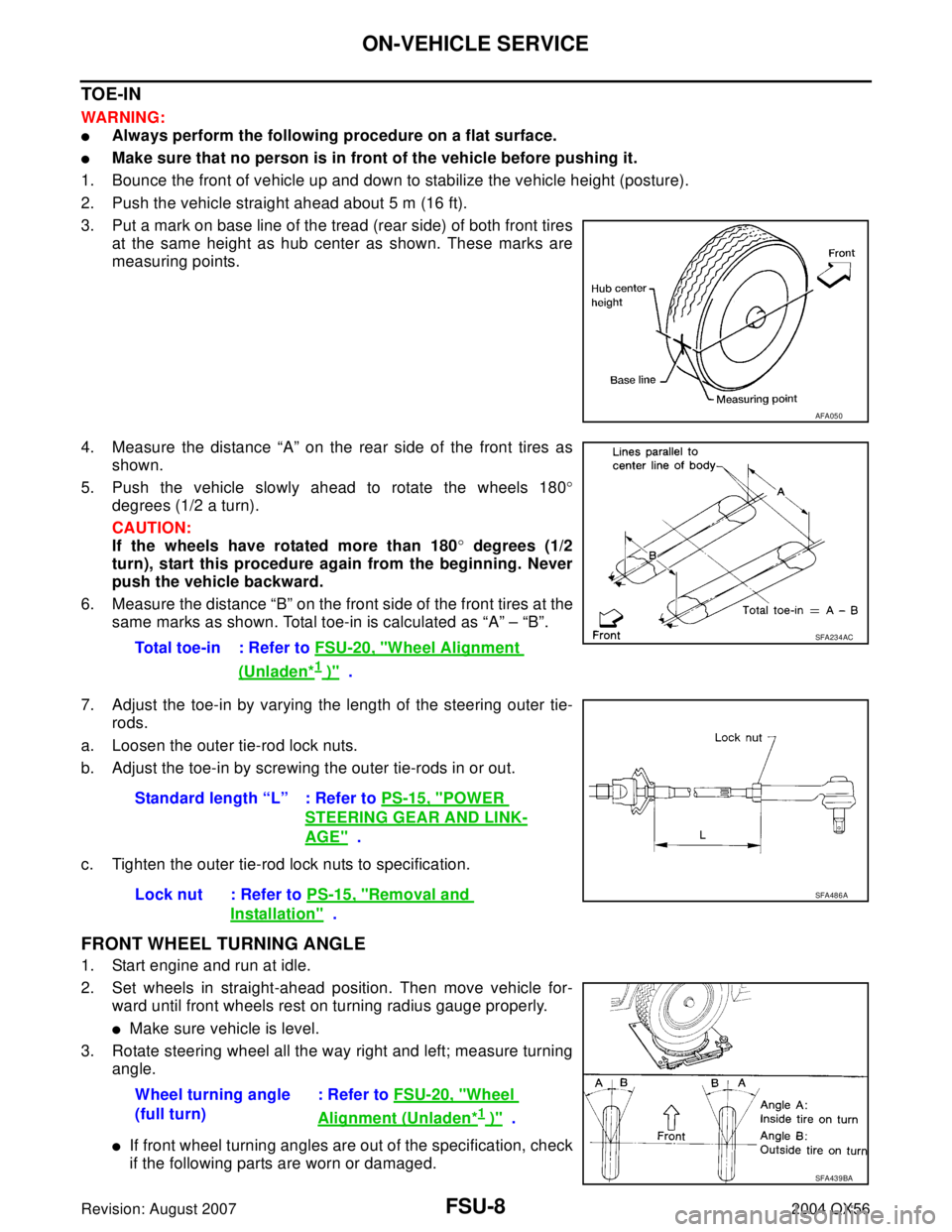Page 1974 of 3371

CYLINDER BLOCK
EM-91
C
D
E
F
G
H
I
J
K
L
MA
EM
Revision: August 20072004 QX56
�If out of specification, replace piston ring. If gap still exceeds the limit even with a new ring, re-bore cylin-
der and use oversized piston and piston ring.
CONNECTING ROD BEND AND TORSION
�Check the connecting rod alignment using suitable tool.
�If measurement exceeds the limit, replace connecting rod
assembly.
CONNECTING ROD BEARING (BIG END)
�Install the connecting rod cap without the connecting rod bearing
installed. After tightening the connecting rod bolt to the specified
torque, measure the connecting rod large end inside diameter.
Refer to EM-77, "
ASSEMBLY" .
�If measurement exceeds the standard, replace the connecting
rod.
CONNECTING ROD BUSHING OIL CLEARANCE (SMALL END)
Connecting Rod Inside Diameter (Small End)
�Measure inside diameter of bushing using suitable tool.Limit:
Bend
: 0.15 mm (0.0059 in) per 100 mm (3.94 in) length
To r s i o n
: 0.30 mm (0.0118 in) per 100 mm (3.94 in) length
SEM 00 3F
SEM 03 8F
Standard : 57.000 - 57.013 mm (2.2441 - 2.2446 in)
PBIC1641E
Standard : 22.000 - 22.006 mm (0.8661 - 0.8664 in)
PBIC0120E
Page 1985 of 3371
EM-102Revision: August 2007
SERVICE DATA AND SPECIFICATIONS (SDS)
2004 QX56
CYLINDER HEAD
Unit: mm (in)
Valve Dimensions
Unit: mm (in) Items Standard Limit
Head surface distortion 0.03 (0.0012) 0.1 (0.004)
Nominal cylinder head height “H” 126.3 (4.97)
KBIA2554E
Valve head diameter “D”Intake 37.0 - 37.3 (1.457 - 1.469)
Exhaust 31.2 - 31.5 (1.228 - 1.240)
Valve length “L”Intake 96.21- 96.71 (3.7878 - 3.8075)
Exhaust 93.74 - 94.24 (3.6905 - 3.7102)
Valve stem diameter “d”Intake 5.965 - 5.980 (0.2348 - 0.2354)
Exhaust 5.955 - 5.970 (0.2344 - 0.2350)
Valve seat angle “α”Intake
45°15′ - 45°45′
Exhaust
Valve margin “T”Intake 1.1 (0.043)
Exhaust 1.3 (0.051)
SEM188
Page 1986 of 3371

SERVICE DATA AND SPECIFICATIONS (SDS)
EM-103
C
D
E
F
G
H
I
J
K
L
MA
EM
Revision: August 20072004 QX56
Valve Guide
Unit: mm (in)
Valve Seat
Unit: mm (in)
Valve Spring
Items Standard Oversize [0.2 (0.008)] (service)
Valve guideOutside diameter 10.023 - 10.034 (0.3946 - 0.3950) 10.223 - 10.234 (0.4025 - 0.4029)
Inside diameter (Finished size) 6.000 - 6.018 (0.2362 - 0.2369) —
Cylinder head valve guide hole diameter 9.975 - 9.996 (0.3927 - 0.3935) 10.175 - 10.196 (0.4006 - 0.4014)
Interference fit of valve guide 0.027 - 0.059 (0.0011 - 0.0023)
Items Standard Limit
Stem to guide clearanceIntake 0.020 - 0.053 (0.0008 - 0.0021) 0.08 (0.0031)
Exhaust 0.030 - 0.063 (0.0012 - 0.0025) 0.09 (0.0035)
Projection length “L”Intake 12.6 - 12.8 (0.496 - 0.504)
Exhaust 12.5 - 12.9 (0.492 - 0.508)
KBIA2555E
Items Standard Oversize [0.5 (0.020)] (Service)
Cylinder head seat recess diameter (D)Intake 38.000 - 38.016 (1.4961 - 1.4967) 38.500 - 38.516 (1.5157 - 1.5164)
Exhaust 32.200 - 32.216 (1.2677 - 1.2683) 32.700 - 32.716 (1.2874 - 1.2880)
Valve seat interference fitIntake 0.081 - 0.113 (0.0032 - 0.0044)
Exhaust 0.064 - 0.096 (0.0025 - 0.0038)
Valve seat diameter (d)Intake 38.097 - 38.113 (1.4999 - 1.5005) 38.597 - 38.613 (1.5196 - 1.5202)
Exhaust 32.280 - 32.296 (1.2709 - 1.2715) 32.780 - 32.796 (1.2905 - 1.2912)
KBIA2541E
Free height mm (in)50.58 (1.9913)
Pressure N (kg, lb) at height mm (in)Installation 165.8 - 187.0 (16.9 - 19.1, 37 - 42) at 37.0 (1.457)
Valve open 314.8 - 355.0 (32.1 - 36.2, 71 - 80) at 28.2 (1.110)
Out-of-square mm (in) Less than 2.2 (0.087)
Page 2008 of 3371

DRIVE SHAFT
FAX-11
C
E
F
G
H
I
J
K
L
MA
B
FA X
Revision: August 20072004 QX56
7. Install the boot securely into the grooves (indicated by * marks)
as shown.
CAUTION:
If there is grease on boot mounting surfaces (indicated by *
marks) of shaft and housing, boot may come off. Remove
all grease from surfaces.
8. Check that the boot installation length “L” is the length indicated
below. Insert a flat-tip screwdriver or similar tool into the big end
of the boot. Bleed air from the boot to prevent boot deformation.
CAUTION:
�The boot may break if the boot installation length is less than the specified value.
�Do not to touch the tip of the screwdriver to the inside of the boot.
9. Secure the big and small ends of the boot with the new boot
bands as shown.
NOTE:
Discard the old boot bands and use new ones for assembly.
10. After installing the sliding joint housing to the drive shaft, rotate the boot to check that the boot is posi-
tioned correctly. If the boot is not positioned correctly, reposition the boot and secure the boot using a new
boot band.
Wheel Side
1. Insert the Genuine NISSAN Grease or equivalent, into the joint
sub-assembly serration hole until the grease begins to ooze
from the ball groove and serration hole. Refer to MA-10, "
REC-
OMMENDED FLUIDS AND LUBRICANTS" . After inserting the
grease, use a shop cloth to wipe off the grease that has oozed
out.
2. Wrap the serrated part of the drive shaft with tape. Install the
boot band and boot onto the shaft. Do not damage the boot.
NOTE:
Discard the old boot band and boot and use a new one for
assembly.
3. Remove the protective tape wound around the serrated part of
the drive shaft.Boot installation length “L ” : 145 mm (5.71 in)
WDIA0287E
SFA39 5
SDIA11 27 E
SFA80 0
Page 2009 of 3371

FAX-12
DRIVE SHAFT
Revision: August 20072004 QX56
4. Attach the circlip to the drive shaft. The circlip must fit securely
into the drive shaft groove. Attach the nut to the joint sub-assem-
bly.
Use a soft hammer to press-fit the circlip.
NOTE:
Discard the old circlip and use a new one for assembly.
5. Insert the specified quantity of Genuine NISSAN Grease or
equivalent, into the joint sub-assembly and the large end of the
boot. Refer to MA-10, "
RECOMMENDED FLUIDS AND LUBRI-
CANTS" .
6. Install the boot securely into the grooves (indicated by the *
marks) as shown.
CAUTION:
If there is grease on the boot mounting surfaces (indicated
by the * marks) of the drive shaft and joint sub-assembly,
the boot may come off. Remove all grease from the drive
shaft surfaces.
7. Check that the boot installation length “L” is the specified length.
Insert a flat-tip screwdriver or similar tool into the big end of the
boot. Bleed the air from the boot to prevent boot deformation.
CAUTION:
�The boot may break if the boot installation length is less than the specified length.
�Do not contact inside surface of boot with the tip of the screwdriver.
8. Secure the big and small ends of the boot using new boot bands
as shown.
NOTE:
Discard the old boot bands and use new ones for assembly.
9. After installing the joint sub-assembly to the drive shaft, rotate the boot to check that it is positioned cor-
rectly. If the boot is not positioned correctly, reposition the boot and secure the boot using a new boot
band.Grease capacity : 145 − 165 g (5.11 − 5.82 oz)
RAC0049D
Boot installation length “L” : 168.4 mm (6.63 in)WDIA0288E
SFA39 5
Page 2010 of 3371
SERVICE DATA AND SPECIFICATIONS (SDS)
FAX-13
C
E
F
G
H
I
J
K
L
MA
B
FA X
Revision: August 20072004 QX56
SERVICE DATA AND SPECIFICATIONS (SDS)PFP:00030
Wheel BearingEDS001AN
Drive ShaftEDS001AO
Wheel bearing axial end play 0.05 mm (0.002 in) or less
Drive shaft joint typeFinal drive side Rzeppa
Wheel side Rzeppa
GreaseQualityNissan Genuine Grease or
equivalent
Capacity Final drive side 130 - 150 g (4.58 - 5.29 oz)
Wheel side 145 - 165 g (5.11 - 5.82 oz)
Boot length Final drive side "L " 145 mm (5.71 in)
Wheel side "L " 168.4 mm (6.63 in)
WDIA0055E
Page 2067 of 3371

FSU-8
ON-VEHICLE SERVICE
Revision: August 20072004 QX56
TOE-IN
WAR NIN G:
�Always perform the following procedure on a flat surface.
�Make sure that no person is in front of the vehicle before pushing it.
1. Bounce the front of vehicle up and down to stabilize the vehicle height (posture).
2. Push the vehicle straight ahead about 5 m (16 ft).
3. Put a mark on base line of the tread (rear side) of both front tires
at the same height as hub center as shown. These marks are
measuring points.
4. Measure the distance “A” on the rear side of the front tires as
shown.
5. Push the vehicle slowly ahead to rotate the wheels 180°
degrees (1/2 a turn).
CAUTION:
If the wheels have rotated more than 180° degrees (1/2
turn), start this procedure again from the beginning. Never
push the vehicle backward.
6. Measure the distance “B” on the front side of the front tires at the
same marks as shown. Total toe-in is calculated as “A” – “B”.
7. Adjust the toe-in by varying the length of the steering outer tie-
rods.
a. Loosen the outer tie-rod lock nuts.
b. Adjust the toe-in by screwing the outer tie-rods in or out.
c. Tighten the outer tie-rod lock nuts to specification.
FRONT WHEEL TURNING ANGLE
1. Start engine and run at idle.
2. Set wheels in straight-ahead position. Then move vehicle for-
ward until front wheels rest on turning radius gauge properly.
�Make sure vehicle is level.
3. Rotate steering wheel all the way right and left; measure turning
angle.
�If front wheel turning angles are out of the specification, check
if the following parts are worn or damaged.
AFA05 0
Total toe-in : Refer to FSU-20, "Wheel Alignment
(Unladen*1 )" .
SFA234AC
Standard length “L” : Refer to PS-15, "POWER
STEERING GEAR AND LINK-
AGE" .
Lock nut : Refer to PS-15, "
Removal and
Installation" .
SFA486A
Wheel turning angle
(full turn): Refer to FSU-20, "Wheel
Alignment (Unladen*1 )" .
SFA439BA
Page 2087 of 3371

GI-6
PRECAUTIONS
Revision: August 20072004 QX56
(i.e. Flexible Fuel Vehicle - FFV models). Using a fuel other than that specified could adversely affect
the emission control devices and systems, and could also affect the warranty coverage validity.
Precautions for Multiport Fuel Injection System or Engine Control SystemEAS0014B
�Before connecting or disconnecting any harness connector for
the multiport fuel injection system or ECM:
Turn ignition switch to “OFF” position.
Disconnect negative battery terminal.
Otherwise, there may be damage to ECM.
�Before disconnecting pressurized fuel line from fuel pump to
injectors, be sure to release fuel pressure.
�Be careful not to jar components such as ECM and mass air
flow sensor.
Precautions for HosesEAS0014C
HOSE REMOVAL AND INSTALLATION
�To prevent damage to rubber hose, do not pry off rubber hose
with tapered tool or screwdriver.
�To reinstall the rubber hose securely, make sure of hose inser-
tion length and clamp orientation. (If tube is equipped with hose
stopper, insert rubber hose into tube until it butts up against
hose stopper.)
HOSE CLAMPING
�If old rubber hose is re-used, install hose clamp in its original
position (at the indentation where the old clamp was). If there is
a trace of tube bulging left on the old rubber hose, align rubber
hose at that position.
�Discard old clamps; replace with new ones.
SGI787
SM A01 9D
SM A02 0D
SM A02 1D